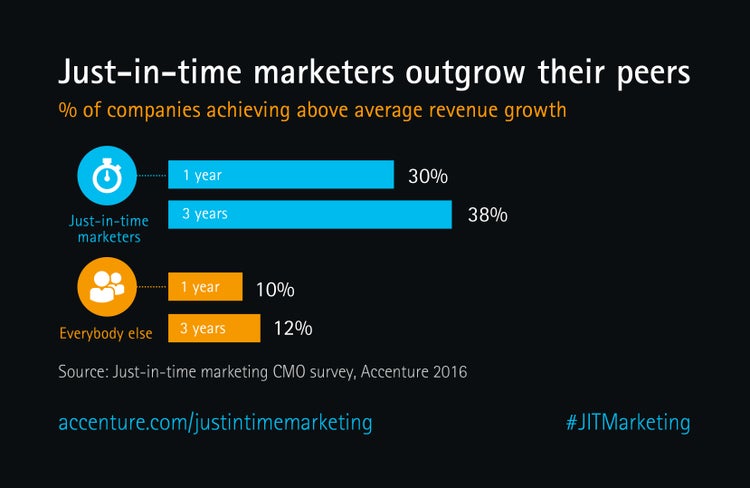June 07, 2016
Just-in-Time Marketing Boosts Revenue Growth, Accenture Report Finds
NEW YORK; June 7, 2016 – Just-in-time marketing can deliver a higher return on marketing dollars and companies pursuing this approach are three times more likely to beat their peers on revenue growth, according to a new report from Accenture (NYSE: ACN) based on a survey of more than 500 chief marketing officers globally.
Just-in-time marketing is focused on creating only marketing content that’s needed, when it’s needed, and attuning it to the needs of interested consumers exactly when they are in the buying mood. In contrast, mass marketing strategies are focused on creating extensive content aimed at reaching the broadest possible audience. According to the survey, this strategy is proving to be less and less successful, as CMOs said that as little as 20 percent of the customers typically reached are interested in the promoted product or able to buy it.
“By adopting just-in-time practices, we’re seeing leading marketing organizations unlock value that was previously trapped or unattainable,” said Paul Nunes, managing director, Accenture Institute for High Performance. “This value accrues mostly from just-in-time marketers’ ability to engage the customer at the exact moment of need and from avoiding wastage.”

Just-in-time marketers are three times more likely to beat their peers on revenue growth
Where just-in-time marketing organizations excel
Thirty-eight percent of the companies which Accenture identified as just-in-time marketers have grown their annual revenues by more than 25 percent compared to just 12 percent of their peers. They are also ahead of the curve regarding the following capabilities:
- Waste consciousness – 82 percent report large efforts to minimize marketing inefficiencies (peers: 49 percent).
- Right-time marketing flexibility – 57 percent are “very satisfied” with their ability to share the right message with consumers at the right time (peers: 36 percent).
- Ability to generate customer insight – 87 percent have employees with specialized analytical skills to develop actionable customer insights (peers: 67 percent).
- Higher digital integration – Just-in-time marketing companies don’t isolate digital marketing efforts from the rest of their marketing organization, as 58 percent described their digital and traditional marketing initiatives as “very highly integrated” (peers: 19 percent).
- Freedom with technology – 58 percent report “complete independence” when it comes to making IT investment decisions (peers: 14 percent) – indicating that the CIO-CMO relationship has grown more collaborative in just-in-time marketing companies.
“Just-in-time marketing organizations provide more satisfying and engaging customer experiences,” said Rob Davis, managing director, Accenture Interactive. “To deliver on the personalized experience customers expect, they have changed their marketing operating model, for example, by integrating digital and analytics. The winners will be those who balance creative excellence with operational rigor.”
Watch video: Waste or Win? The Case for Just-in-Time Marketing
Key steps on the path to just-in-time marketing
Marketing organizations wanting to transform into just-in-time organizations should consider the following recommendations:
- Optimize operations. Sharpen operations and train people to execute quickly; to react smarter and more nimbly; to glean insights and turn them around in days or weeks, not months. Put talent and decisions closer to the front line, aggregate the insights and act on them. Optimize your governance structure and make sure you know who is accountable and responsible for every decision, eliminating process steps and handoffs where possible.
- Become an effective “listener.” Listen through social media for cues to take immediate action, and become more comfortable using unstructured data to make decisions based on a combination of data-based insights and instincts.
- Solve for leading indicators not just for the masses. Set the unit of analysis at individual interactions along with a broad campaign approach as a means of achieving total quality among customer interactions. It’s not only necessary to address the masses today, but also to consider those who are predictors of what the norm will be in the future.
“Marketing organizations are increasingly held accountable for delivering tangible business outcomes,” said Mark Hosbein, managing director, Marketing BPO, Accenture Operations. “To provide an edge in the marketplace, traditional marketing organizations should invest in the capabilities and technologies that will transform their operations, moving them toward an as-a-service model.”
For the report “Building the Just-in-Time Marketing Organization,” the Accenture Institute for High Performance surveyed 532 chief marketing officers between September and November 2015. Participating CMOs represented companies headquartered in 11 countries, across 10 industries, with reported revenues of more than US$1 billion. For additional perspective on the research from Accenture Interactive, click here. For insight from Accenture Operations, click here.
About Accenture
Accenture is a leading global professional services company, providing a broad range of services and solutions in strategy, consulting, digital, technology and operations. Combining unmatched experience and specialized skills across more than 40 industries and all business functions – underpinned by the world’s largest delivery network – Accenture works at the intersection of business and technology to help clients improve their performance and create sustainable value for their stakeholders. With approximately 373,000 people serving clients in more than 120 countries, Accenture drives innovation to improve the way the world works and lives. Visit us at www.accenture.com.
# # #
Contacts:
Jens R. Derksen
Accenture
+ 49 175 57 61393
[email protected]
Hannah Unkefer
Accenture
+ 1 415 537 4848
[email protected]